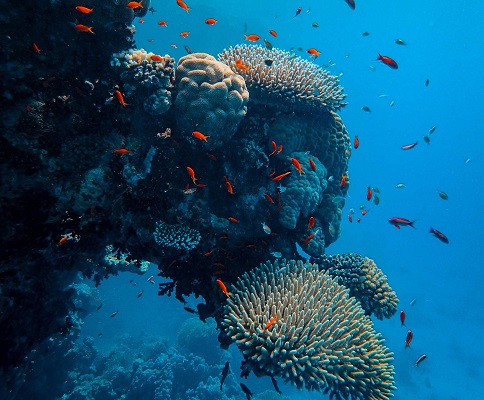The Climate Cult echo chamber is full voice after the BBC published a misleading bit of global terrorism this week titled “Coral bleaching: Fourth global mass stress episode underway – US scientists.”
Coral around the world is turning white and even dying as recent record ocean heat takes a devastating toll. It has triggered the fourth global mass coral bleaching event, according to the US National Oceanic and Atmospheric Administration (NOAA). Bleaching happens when coral gets stressed and turns white because the water it lives in is too hot. …
Scientists in the US, Australia, Kenya and Brazil told BBC News about feeling dismay and even anger as they watched the coral they love threatened or killed by warm oceans.
The timing couldn’t be better. NOAA has been pimping its warm Atlantic beware of this year’s hurricane season narrative for weeks. Can you imagine if there was a series of stories linking catastrophic events (real or imagined) to warming oceans? Think of all the money you could launder into the pockets of researchers who wash, rinse, and repeat in that allegedly over warm water.
And the control! Think about how it can sway underinformed peasants to let their governments manage their lives. Someone somewhere is having a climate narrative orgasm.
Forget that NOAA is hardly an unbiased source, but would you be willing to bet on them if a renowned expert on Coral dared to contradict their hyperbolic claims? You would with other people’s money, and they will, but for those interested in another view, Dr. Peter Ridd says there’s nothing to see here. That “bleaching” is merely part of a natural process, when coral expels algae in order to switch to a different type which is more suitable adapted to new conditions.”
According to Ridd, coral cover on the Great Barrier Reef last year reached record levels, despite four supposedly catastrophic bleaching events in the six years prior to 2022. Neither has there been any significant change in corals worldwide.
So what. Who the heck is this Ridd person, anyway?
Peter Ridd is a physicist. He has researched the Great Barrier Reef since 1984, and has published over 100 scientific publications. A former head of the Marine Geophysical Laboratory at James Cook University, Townsville, Australia, he was fired in 2018 for pointing out quality assurance deficiencies in reef-science institutions. He presently works, without payment, on science quality assurance issues. He is an adjunct fellow of the Institute of Public Affairs and a member of the Academic Advisory Council of the Global Warming Policy Foundation.
So, a nobody, except that he did write the 2023 analysis of global coral for The Global Warming Policy Foundation, in which we find this (reformatted, footnotes removed, see original).
For example, the discovery that the GBR had the highest coral cover on record in 2022 was immediately downplayed by reef science and management institutions, and the media too. It was claimed that only the fast-growing corals53 had recovered. However, since these were also the corals most susceptible to bleaching (and also to hurricanes and crown-of-thorns starfish), it was also claimed that this left the reef more vulnerable. However, since these corals were also the most susceptible to bleaching, hurricanes, and crown-of-thorns starfish, they were also the most threatened.
The argument is unsustainable, however, because these fast-growing (and vulnerable) corals were the ones that were alleged to have been killed by the four bleaching events in the last six years. While they can indeed regrow extremely rapidly (within a year) from a small section that is left alive (the so-called ‘phoenix effect’), if they are killed, recruitment of larvae and regrowth takes 5–10 years.56 They cannot regenerate within a few months.
The rapid recovery of the reef cover therefore shows that they were bleached, but not killed. In other words, the past few years’ data has proven that very little coral was killed by the bleaching events – even the fast- growing coral that is most susceptible. Coral reefs can double or even quadruple their coral in a decade. The loss of a few percent from bleaching is a minor disturbance. When the reef cover crashes, it is almost always the fast-growing coral that declines, so it is hardly surprising, and certainly not concerning, when the fast-growing coral comes back.
Read the report (pages 17 – 24) for more embarrassing realities you won’t find from the BBC or anyone who echos its climate alarmism. Trigger warning: Science! Like this,
The records show that there were 26 records of coral bleaching events in the world before 1982; bleaching was observed on the first scientific expedition to the GBR, from England, in 1929. Possibly the earliest representation of bleaching is a remarkable lithograph (Figure 15) by von Ransonnet, published in 1862. There can be no doubt that bleaching is not a ‘novel’ phenomenon.
There is also the matter of eyeballs. Prior to 1990, there were very few scientists regularly observing reefs with any consistency, if at all. “If a major bleaching event had occurred in, say, 1925, who would have noticed?
And finally, at lest for this post, bleaching happens when the zooxanthellae, with whom coral have a symbiotic relationship, are ejected “as a survival strategy.
Corals bleach because the zooxanthellae within them have become ‘poisonous’, or at least disadvantageous, to the polyp and must be expelled.”
There are a lot of reasons for this from too warm or too cool water, sunlight, fresh water dilution of seawater, and so on. All of this occurred long before someone discovered the potential for attention, wealth, and power to those who embrace scientism to advance political policy that has nothing to do with protecting the planet or those on it.
